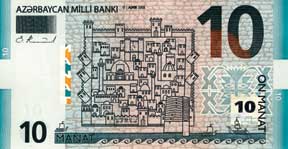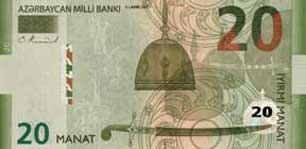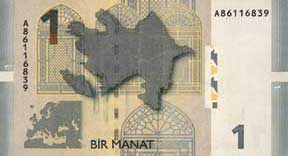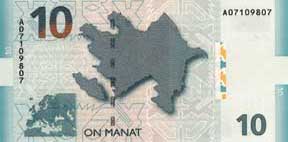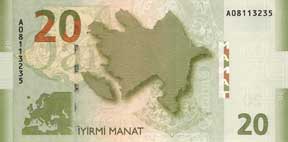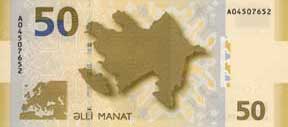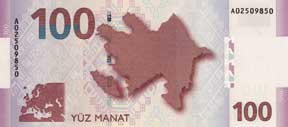|

Autumn 2006 (14.3)
Pages
64-69
Economy
Azerbaijan's
New Manats:
Design and Transition to a New Currency
by Sevinj Mehdizade,
With appreciation for assistance from the staff of Azerbaijan
National Bank
  It's
a scene all too familiar in Azerbaijan these days: a woman walks
into a clothing store and discovers a beautiful dress that she
would like to buy. But then comes the process of calculating
the cost and purchasing the item. It's
a scene all too familiar in Azerbaijan these days: a woman walks
into a clothing store and discovers a beautiful dress that she
would like to buy. But then comes the process of calculating
the cost and purchasing the item.
"How much is it?" she inquires. "Seventeen Manats,
80 kopeks," comes the reply.
The lady reaches into her purse to discover that she has only
12 of the new bills called "Yeni Manat" (New Manat)
and only 50 of the new kopeks. She offers the bills and coins
to the clerk who makes a mental calculation and politely reminds
her that she still owes 5 Manats and 30 kopeks or 26,500 "old
manats".
Again, the lady digs into her purse and finally manages to pull
out the necessary 26,500 in old manat bills. She presents them
to the clerk, takes her purchase and walks out. And then she
frets all the way home: "Was she charged correctly or not?"
Scenarios of this sort are quite common ever since Azerbaijan
adopted its new currency. It's almost a year since the Yeni Manat
bills began to circulate. The presentation ceremony was held
at the Baku's Excelsior Hotel on December 28, 2005. Since January
2006 the new bills have gradually been introduced and circulated
throughout society.
Transition Year
This year - 2006 - exchanges have been allowed in both currencies
- the Yeni Manats as well as the old manats. This year is considered
to be the transition year when both old and new manats are both
permitted for daily exchange. In shops and department stores,
charts often display the equivalent values of both currencies.
But, all in all, it hasn't been easy getting used to the new
bills and new denominations. In truth, it's been a rather slow,
complicated and sometimes a quite confusing process.
Though all of the new denominations were in circulation by April,
instead of people turning in all their old manats in exchange
for new ones, most people just mixed them all together - offering
bills in both formats for purchases and receiving change back
for single purchases often in both currencies as well.
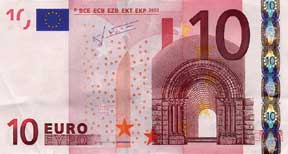 |
 |
Above: Examples of Euro banknotes. Robert
Callina from OeBS Company in Austria designed both the Euro and
Azerbaijan's Manat. The Euro is based on architectural designs
found in Europe through the ages. In many of Azerbaijan's banknotes,
architecture features are included. Except for the one Manat
and the 20 Manat bill, architecture also appears in the designs
of Azerbaijan's Yeni Manat. Azerbaijan's currency has incorporated
many of the same safeguards against counterfeiting that appear
in the Euros.
It's only natural that most people still understand the value
of the old manats more than the new ones. Five thousand (5,000)
old manats equal one (1) Yeni Manat. This was thought to be approximately
equal to currency of developed countries (1 Manat = US 1 dollar
or 1 Euro). Of course, in reality the Euro has already edged
higher than the dollar.
Old Manats
The old manats were introduced as new currency when Azerbaijan
gained its independence in late 1991. During the Soviet period,
the currency in use in Azerbaijan was based upon the rubles and
kopeks. By 1992, Azerbaijan had its own new currency printed-manats.
There were no more rubles or kopeks. The manat at that time was
valued at approximately 4,000 manats to the dollar.
The old currency consisted entirely of bills-no coins-in denominations
of 1,000, 10,000 and 50,000 manats. Nothing larger. Since the
rate was approximately 4,000 manats to one dollar, it meant that
denominations smaller than 1,000, such as 500, 250 and 100 were
hardly worth anything. People often collected them to pass out
to beggars that they passed so frequently on the streets.
Yeni Manat bills are printed in the following denominations:
1, 5, 10, 20, 50, and 100. It would have been so much easier
to do the mental gymnastics if the new currency had simply removed
the zeros from the old currency in terms of value. Instead, one
has to multiply the new bill by 5,000 to understand what the
old amount was. For instance, we used to buy bread for 1,000
manats (about 25 cents), but now we pay 20 kopeks for it.
Design
of Yeni Manat
According
to information obtained from the Azerbaijan National Bank, a
competition was held with the particiopation of international
designers. The following countries took part: Germany (Giesecke
& Devrient), Great Britain (De La Rue), Switzerland (Oriel
Fussli), Austria (OeBS), Holland (Enchede Banknotes) and France
(Oberthur).
Robert Callina from Austrian OeBS Company was declared the winner
of the competition. He is also the artist and designer of the
Euro. Some people have expressed disappointment that Azerbaijanis
seemed not be invited to participate in the competition as the
designs in general don't have as much indigenous flavor in style,
especially the higher denomination bills.
The design of the banknotes was based on the concept of creating
a single unifying design for all the bills. This has been successfully
carried out in many respects related to colors, fonts and patterns.
All banknotes generally follow the same motif on their reverse
side which features two maps. The most dominant map is that of
Azerbaijan. The outline of the map of Azerbaijan, often described
as an eagle in flight towards the East, includes Garabagh [Karabakh],
in the western part of Azerbaijan which has been under Armenian
military occupation since 1992. This is Azerbaijan's territory
but all Azerbaijanis have been "ethnically cleansed"
from the area. In plain language, that means that they were forced
to flee the lands or risk losing their lives. |
Kopeks
Kopeks enable the government to avoid additional expenses in
reissuing money as coins being manufactured out of metal last
much longer than paper banknotes.

Above: Coins called "kopeks"
are circulating now that Yeni Manat (New Manats) were put into
circulation early in 2006.
Kopeks have been issued in the following denominations of 1,
3, 5, 10, 20, and 50. Their designs follows the same progression
of themes as do the Yeni Manat banknotes: 1 kopek (Culture, featuring
traditional instruments used in performing modal music-mugham);
3 kopeks (Writing and Literature); 5 kopeks (History, featuring
Maiden Tower); 10 kopeks (Karabakh, territory in the western
region Azerbaijan over which a bitter war was fought with Armenians
from 1988 until a cease fire was signed in 1994. Azerbaijanis
consider the war yet unresolved since about 15 percent of their
territory has been seized and is being held under occupation);
20 kopeks (Education and Future); and 50 kopeks (Economy and
Progress).
However, many problems arise with the use of kopeks. When the
sum is less than half a kopek - you round the sum downwards.
For example, if something costs 35.4 kopeks, you would pay 35
kopeks. However, if an item costs more than half a kopek, such
as 35.6 kopeks, then you have to round upwards and pay 36 kopeks.
Why the New Currency
According to the National Bank of Azerbaijan, three explanations
are given as official reasons why Azerbaijan adopted a new banknote
system: economic, technical and aesthetic.
Economically, the result of inflation and devaluation of currency
always carry serious consequences and cause people to lose confidence
in the national currency. When the currency rate is high, it
usually prompts new inflation and results in "dollarization"
of the economy and monetary issues become difficult and complicated
by high prices.
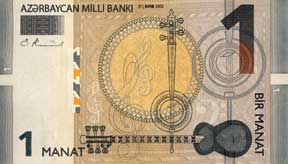 |
 |
Above Left: One Yeni Manat featuring traditional
instruments used in performing mugham music-tar, kamancha and
gaval).
Right:
Five Yeni Manat, featuring
Language and Literature.
Technically, counterfeiting bills has become relatively easy
these days due to modern technology. Counterfeit bills often
circulate successfully as people are not usually very aware of
the protective elements designed into banknotes and don't know
how to identify forgeries.
The Azeri Yeni Manat has been designed to counter fraudulent
attempts by incorporating a counterfeiting system in consultation
with the National Bank of Switzerland. They claim that the Yeni
Manat banknotes have 30 different elements that can distinguish
these bills from fraudulent bills.
Above Left: Ten Yeni Manat, featuring a stylized
sketch of the Old City of Baku (Ichari Shahar).
Right: Twenty Yeni Manat bill features Karabakh
and is illustrated with symbols of war from medieval times: helmet,
shield and sword. Notice (left of center) the white outline of
a flower, Khari bulbul, which is indigenous to the region.
Aesthetically, in many
countries, banknotes are gathered up and taken out of circulation
every four years. Then new banknotes are reissued. However, many
of the old banknotes in Azerbaijan have been circulating for
more than 10 years. It doesn't take long before they look all
crumpled, tattered, very dirty and consequently very inhygienic.
Nicknames for banknotes
The new currency is so new that people have not quite developed
a vocabulary for it. Certain denominations of the old currency
had nicknames. For example, the very small denomination of the
old 500-manat bill featured the portrait of the beloved poet
Nizami. People called the bill "Nizami".
The old 1,000 manat bill with the portrait of Mammad Amin Rasulzade
went by various names: "Mammad," "Mammad Amin"
and even "Baldy". Rasulzade was the head of the ruling
Musavat political party that gained independence for Azerbaijan
(1918-1920). This government existed for only 23 months before
the Bolsheviks took control and set up the Soviet government,
which lasted until 1991.
 |
 |
Above
Left: Fifty Yeni Manat bill,
dedicated to Education and Progress. However, starting with the
50-bill denomination, the design of the banknote has very little
to do specifically with anything that is Azeri. Here nothing
except the honeycomb stalactite decorative architectural feature
above the passage way in the center of design relates to Azerbaijan.
The other architectural structures are not from Azerbaijan.
Right: The One Hundred Yeni Manat bill is dedicated
to Economy and Progress. Only the small inset showing the citadel
walls and double gates of the Old City (Ichari Shahar) are designs
that relate to Azerbaijan.
The old 10,000-manat bill was typically referred to as "Shrivan"
because it featured the 15th century palace, which belonged to
the Shirvan shahs inside the Old City walls of Baku.
The old 50,000-manat banknote featuring the 12th century Momina
Khatun Mausoleum in Nakhchivan sometimes was referred to as "Momina
Khatun". She was the wife of Eldagiz Atabey Jahan Pahlavi
who commissioned the monument to be built in her memory. No doubt
within time, the Yeni Manats will acquire their own nicknames
as well.
Plans
for 2007
Beginning January 1, 2007, this difficult transition period is
supposed to be finished. Only Yeni Manat will officially supposed
be in circulation. The old manats can be traded for new ones
at banks. Maybe life will be a lot less complicated and we'll
no longer have to carry out mental gymnastics coping with two
currencies.
Above: The reverse sides of all of the Azerbaijan
Yeni Manat. The same two maps are incorporated into each of the
designs. The larger map features Azerbaijan; the smaller is of
Europe and includes Azerbaijan. A closer look at the bill shows
that the subtle decorative designs behind the maps are distinctly
different on each bill. Often the design is taken from carpets.
|
Yeni Manats Put in
Circulation
Gradual Introduction in
2006
January 1 and 5 Yeni Manat
Plus all kopeks
March 10 and 20 Yeni Manat
April 50 and 100 Yeni Manat
By January 2007, the Azerbaijani
government intends all exchange to be carried out in Yeni Manat.
|
Features
to Assist the Blind
The Azerbaijan Yeni Manat was based on the design of Euro banknotes,
which include several characteristics to assist the blind in
distinguishing the different denominations of the notes. These
were incorporated into the design in cooperation with organizations
representing blind persons. Such characteristics aid both people
who are visually impaired (people who can see the banknotes,
but cannot necessarily read the printing on them) and those who
are entirely blind.
Size: For example, both Manat and Euro banknotes increase in
size with increasing denominations. Each larger bill increases
in increments of seven millimeters.
Color: The predominant coloring of the notes alternates between
"warm" and "cool" hues in adjacent denominations,
making it easier to distinguish between two similar denominations
for those who can see color.
Printing process: The printing of the denominations is intaglio
printing, which allows the ink to be felt by sensitive fingers,
enabling some persons to distinguish the printed denominations
by touch alone.
Holograms: Lower denominations have smooth bands along one side
of the note containing holograms; higher denominations have smooth,
square patches with holograms. |
Measures
that Protect Azerbaijan's Yeni Manat Currency From Being Counterfeited
Distinguish between
the red and gray lines in the illustration above: red lines indicate
elements that appear at the same location on all banknotes. This
includes such features as the Watermark and Latent Image see-through
elements.
Gray lines indicate that these features are located in different
places on each banknote. For example, the iridescent stripe read
by computers on the front of the One Yeni Manat banknote appears
on the musical instrument tar. On the Five Manat bill, it appears
on the writers' monuments.
Microtext
Each bill has words that are printed in tiny fine print called
Microtext which are different on each banknote and appear in
different locations.
1. One (1) Yeni Manat. Look on the two outer rings of the design
of the kamancha for the words "BIR MANAT" (one manat)
running continuously around the rim. Also the word "MANAT"
appears just below where the strings are tightened on the tar,
as well as on the vertical line of the main treble clef and the
base of the kamancha. The letters "AMB" which abbreviate
"Azerbaycan Milli Banki" (Azerbaijan National Bank
) run up and down on either side of the spike at the bottom of
the kamancha.
2. Besh (5) Yeni Manat. "MANAT" can be found on the
short bookmarker.
3. On (10) Yeni Manat. The abbreviation "AMB" alternates
with the term "ON MANAT" (10 manat) and runs along
the lower border of the citadel wall at bottom of sketch. Also
the letters "BAKI" (Azeri for "Baku") can
be found above the entrance to the Old City. Two buildings include
the numeral "10". On five domes, you'll find tiny script
with the term "ON MANAT" and one mosque has "AMB".
4. Iyirmi (20) Yeni Manat. Look closely on the main helmet and
you'll see a border of the repeated numeral "20"; and
at the bottom of the rim, there is a series of "IYIRMI MANAT".
5. Alli (50) Yeni Manat. Look closely at the rim on the top step
for the Microtext for "ALLI MANAT"
6. Yuz (100) Yeni Manat. Look for "AZERBAYCAN" above
the doorway of the entrance in the 19th century building ghosted
in the middle of the design.
Other European
Protection Features
Above: 1. Latent Image. 2. Watermark. 3. See-through element.
4. Optical variable ink (from green to red), special dyes with
optic changing colors (OVI) made in Sweden by the SICPA company.
This has an ultrafine pattern. 5. Tactile elements for the blind
and visually impaired, such as embossed numerals. 8. Holographic
feature which produces a three-dimensional effect Trust Seal
holograph manufactured by the German company Kurtz.
There are also other features which incorporate Optic lines (IRISAFE)
which have been produced by the Swedish company Landgarft. Also
there are Ultra-violet elements, Security Thread, and a strip
which only computers can read. In addition there are protection
elements specific and only known by the National Bank of Azerbaijan. |
Scanning
Manats - Photoshop
Editor's Note: After we scanned the Yeni Manat banknotes for
this issue, we found that the Adobe Photoshop program had already
detected that we were working with banknote images. Obviously,
this is one more built-in deterrents related to the Yeni Azerbaijan
Manat to help prevent counterfeit and fraud. This is a new development.
The following message appeared on our computer screen:
"This application does not support the printing of banknote
images. You can open and edit this image but you will not be
able to print it as is. For more information, go to www.rulesforuse.org."
"The counterfeiting of currency is a crime. While the overall
economic losses to society from counterfeiting of currency are
generally limited, the victims who suffer the most harm are individuals
and businesses because no one reimburses those who accept counterfeit
notes. Counterfeit currency can also undermine confidence in
the payment system, making the public uncertain about accepting
cash for transactions.
"The Central Bank Counterfeit Deterrence Group (CBCDG) is
responsible for this website. A counterfeit deterrence system
(CDS) has been developed by the CBCDG to deter the use of personal
computers, digital imaging equipment, and software in the counterfeiting
of banknotes. The CDS has been voluntarily adopted by hardware
and software manufacturers, and prevents personal computers and
digital imaging tools from capturing or reproducing the image
of a protected banknote..." |
Back to Index AI 14.3
(Autumn 2006)
AI Home
| Search | Magazine
Choice
| Topics
| AI Store | Contact us
Other Web sites
created by Azerbaijan International
AZgallery.org | AZERI.org | HAJIBEYOV.com
|







